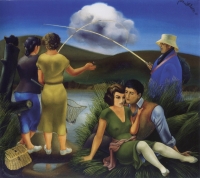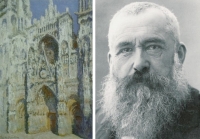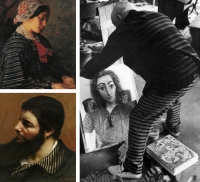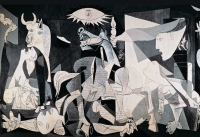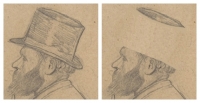18 May 2015
Still-lifes by Peale and Core [from the Archives]
Names are important in art. The American master Charles Willson Peale (1741-1827) had three sons who became painters: Rembrandt, Raphaelle [sic] and Titian. His fourth son was Rubens. Raphaelle is thought to be America’s first still-life painter
02 Dec 2014
How Portraiture Causes Blindness
Specialisation has crippled art history, blinding its practitioners to what is common. For over six years EPPH has been arguing that many portraits by major artists are fusions of the artist's facial features with the sitter's. They were never i
24 Sep 2014 | 2 Comments
Reading Art: Manet, Picasso and Alfonso Ponce de Leon
My vision, like most people’s, is often cloudy which is why when the sun breaks and I gain some understanding, I get excited. You must excuse me. It may sometimes seem as if no-one before me has made similar observations. After all, all my ent
25 Jun 2014 | 2 Comments
Is self-representation self-centered?
(On vacation. A re-post from last summer)
The practical and philosophical issue of whether figures in art depict the artist or the apparent character is well expressed by two different translations of the same text in a Upanishad. The p
25 Feb 2014
Picasso-as-Courbet
Many great artists I follow use a feature other than the face to identify themselves in pictures that are not self-portraits. Given that all their figures represent the artist, they need a variety of methods to hide and reveal their self-referen
13 Jan 2014
Good Art is Not Original
There are some no-nos on EPPH to make conventional minds scream. No biography. Who cares how many women Picasso lived with? It makes no difference to the meaning of Guernica or even to images nominally depicting his loves. No historical or liter
26 Nov 2013 | 2 Comments
Tips to Tell Art from Illustration
My definition of art, as I've said before, is not as wide as that used by the public and most scholars. I do not believe, for instance, that children create art nor the vast majority of adult painters. True artists paint themselves; they paint i
10 Nov 2013 | 3 Comments
Why Art is So Similar
Some readers question whether the common themes of art explained here really exist because, in their minds, art is a product of individual expression. No wonder. That is what children are told and art lovers too. Picasso, for instance, is said t
05 Aug 2013
Why Creative People Are Eccentric
Giorgio Vasari's account of the lives of great artists is full of odd behavior. But even if Vasari's history is part-fiction - as we now know it is - eccentricity is a good sign in a creative mind and quite common. Shelley Carson, a psychologist
03 Apr 2013 | 3 Comments
Art as a Spiritual Guidebook
Some readers may wonder - not many, I hope - how and why I describe so many different figures in art, from the Middle Ages to Picasso, as yet another representation of the artist. It can seem repetitive and boring, even simplistic. Yet it is a b
26 Mar 2013
When Degas made a boob ...on purpose
In a new entry published today you can see for the first time ever how Edgar Degas turned his friend, Edouard Manet (above), into the driver of a carriage holding his whip as a paintbrush flecked with white paint. He then transformed the artist&
20 Mar 2013 | 2 Comments
How Degas drew a top hat…
Art is so pregnant that even in a "simple" sketch like Degas' Edouard Manet at the Races (c. 1865) there is always something more. I thought I had drained the drawing when I finished writing about it yesterday (see entry). And, then, this m
03 Mar 2013
Gauguin Wrestles with Art
Gauguin's great painting of Jacob wrestling with the Angel is commonly known as Vision after the Sermon, perhaps to make sense of the women who were obviously not present in the Bible story. Two years ago I explained the scene as taking plac
18 Feb 2013
1+1=1: The Divided Self in Manet’s Railway
What is the girl up to? Who are they? What's happening? Why do they wear the same color clothes? Why is the girl's hair so odd?
In my explanation two years ago of Edouard Manet’s The Railway (1873) I noted that the extended arm of the
11 Dec 2012
Memory Holloway and Picasso
Memory Holloway, an art historian at the University of Dartmouth, Massachusetts, has written a wonderful book on a magnificent group of etchings by Pablo Picasso. It is titled Making Time: Picasso's Suite 347. Suite 347 is the name given to
16 Oct 2012
Picasso was Rembrandt
Under the theme 'Artist as Other Artist' I show how many painters and sculptors over the centuries have, in one way or another, adopted the persona of an earlier artist. The mask they then inhabit helps disguise their own role within the
28 May 2012
Coins, tablets and Dürer
Coins draw groans. Walk into a roomful of coins in a museum and even the most ardent art lovers hurry through in the hope of finding some painting or sculpture on the other side. Nevertheless the designs on coins are one of the glories of Greek
08 May 2012
Is Painting Art?
This website, EPPH, is founded on a few principles that bear repeating, especially for new users. One of the most important concerns art’s definition. What is art? We believe that drawing and painting are crafts, not arts. Almost any motiv
13 Mar 2012
Titian as Raphael
I've just added an entry on a little-known but very intriguing portrait by Titian, known simply as Titian's Portrait of a Gentleman. Painted around 1520, it is, I believe, Titian's tribute to the recently-deceased Raphael. Hanging in the Palazzo
01 Dec 2011
The Renaissance Portrait from Donatello to Bellini #2
For a late portrait Raphael was asked to paint a Neapolitan princess he had never seen, a problem he solved by sending Giulio Romano to Naples do a drawing from life. The painted portrait (left) was mostly done by studio assistants after a desig
10 Nov 2011
The Importance of an Artist’s Turban
I've been looking forward to discussing turbans for some time because, for an art lover, a little knowledge can go a long way. Almost everyone thinks of them as oriental in some manner but, up until the end of the eighteenth century, you could f
25 Aug 2011
Michelangelo’s Battle with Stone
One of Michelangelo’s earliest sculptures, Battle of the Lapiths and Centaurs, depicts a battle scene in which stones are hurled between the combatants. Barolsky noted that the choice of stones as a weapon was not specified by the classical po
18 Mar 2011
Face Fusion is Everywhere
For years I’ve been rattling on about face fusion to demonstrate that portraits by true artists are not what they seem. Many are not accurate depictions but a fusion of features from different faces, often the artist’s own. Salvador Dali, fo
27 Jan 2011
Larry Rivers and Reincarnation
There is a common idea among major artists that they are part of a continuum of artists with whom they feel at one. So much so, that they can easily take on each other’s identity in a painting: Manet as Rubens, Matisse as Rembrandt etc. Ar
08 Nov 2010
The Reincarnation of Great Masters
Two recent entries, Manet's Croquet at Boulogne on the website and his Copy of Tintoretto's Self-Portrait posted on this blog, have both discussed the feeling, quite common among great artists, that they are reincarna
05 Nov 2010
Manet as Tintoretto
A large number of Manet's early copies after other masters are either self-portraits or depictions of other artists. Art is often the apparent subject. One of his copies is Tintoretto's Self-Portrait (above), of which Carol Armstrong, a Manet sp
01 Nov 2010
Basquiat as Boone as Warhol
I just finished writing an entry on Jean-Michel Basquiat's strange portrait of Mary Boone when I realized I had missed something. It's an example of, no matter how much you see in truly poetic art, there is always something more. In this case, I
The EPPH Blog features issues and commentary.


